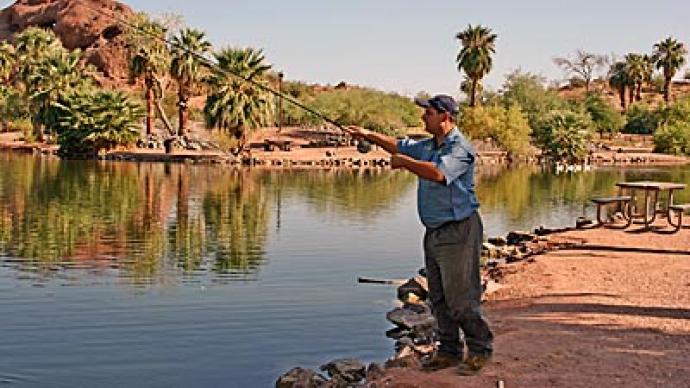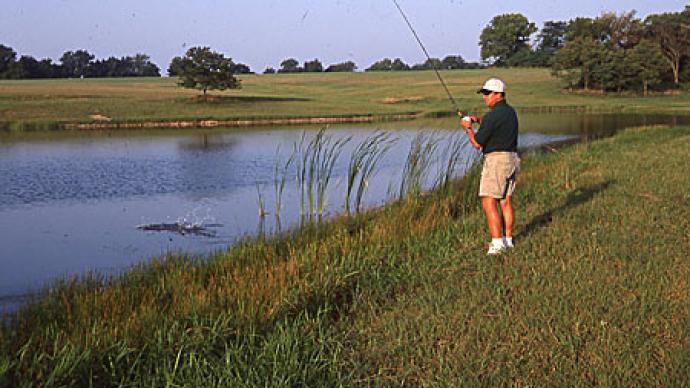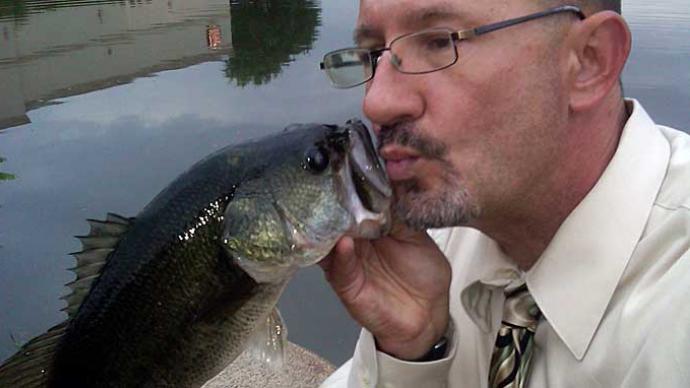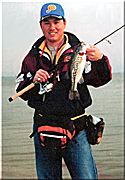
Mention shoreline or bank fishing to most people, and immediately their minds seem to drift to Norman Rockwellesque pictures of summertime, hayseed kids in cut-offs, cane poles, and the ever-present can of worms. This is how we cut our teeth on fishing for many of us. With the rising cost of boat ownership and restricted access to some prime fishing locations, shoreline fishing offers the only real angling alternative for many anglers.
To gain insight into what separates a successful bank angler from the average weekend warrior, Bass West decided to travel somewhere where shoreline fishing is still en vogue - Japan. Boat ownership and operation costs in Japan are nearly double what they are here in the States. Combine this with a minimum of leisure time, and you end up with shoreline fishing being the only option for many anglers. Bank fishing has become such a popular alternative form of fishing in Japan that they even have bass clubs for bank anglers.
We were fortunate to spend a few days with one of Japan's best and brightest anglers - Jun Shoji. Jun's credentials speak for themselves. He is a JB/NBC Angler of the Year, an accomplishment roughly equivalent to being the B.A.S.S. Angler of the Year. Jun also placed fifteenth at the recent tournament held in Florida this past year and has had several top finishes in the Japanese bass circuit. In addition, Jun Shoji is a store manager and instructor at Popeye Co., Japan's largest Ranger boat, Champion boat, Mercury dealer, and one of its finest tackle retailers. Over the course of a year, Jun gives 30 to 40 classes and seminars on bank fishing, and this is where we come into the picture.
"One of the first things I try to get across to the beginning bank angler is to streamline their gear," notes Jun. "Bass anglers especially seem to have too much dependence on their tackle and try to bring the entire tackle shop with them for fear that they won't have the right bait at the right time. This can turn what should be an enjoyable outing into an overblown pack trip. I try to reduce this burden by limiting my students to two rod and reel outfits at a time. Usually, a spinning setup with lighter line in the 6-pound range and a casting outfit filled with 10- to l2-pound test is all you need.
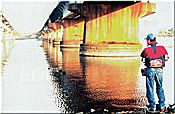
"The nature of shoreline fishing also precludes the use of large, heavy tackle boxes," states Jun. "Bank anglers often find themselves climbing up or down inclines, trudging through narrow openings in the brush, or working across rocky shorelines. Impeded mobility, worrying about where you left your gear, or worse yet, worrying about who might be making off with your tackle box detracts from your concentration and lessens the fun of fishing. One of the main things a bank angler needs to be mobile and self-contained. I teach my students to leave the large boxes at home and place their baits and terminal tackle into smaller utility boxes that easily fit into a backpack or fanny pack. This way, all your essentials are within easy reach, and you never have to backtrack to pick up your gear.
"Bait selections for these tackle packs will depend entirely on the season and location you are fishing," says Jun. "Again, people want to bring every bait for every possible scenario with them - don't. Instead, fill your pack with baits that are not only applicable for the season, but match the characteristics of the body of water you are fishing. For example, if you are fishing a relatively shallow body of water, don't waste your time and space by bringing along the deep diving cranks and 3/4-ounce jigs. Leave them behind! Instead, concentrate on bringing baits that fit well into this type of fishing, from shallow water cranks, spinnerbaits, and jerkbaits, to topwater lures and fluke-type baits. Likewise, if you are fishing in this same lake in the dead of winter, with prevalent cold-water conditions, the fish now have a slower metabolism, so most of your reaction baits will likely be a poor choice. You should now be keying in on slower-moving baits like worms and jigs or suspending rip baits and crankbaits.
"I also try to teach people to choose baits which will match the mode of behavior of the fish," Jun comments. "During the spring and summer months, when fish are actively feeding and moving about, I'll often start fishing a natural reaction bait that covers a lot of water, like a jerkbait. I'll throw topwater lures like a Sammy or a small popper in the early morning or evening hours. However, when the fish are slowing down in the fall and winter, you must also slow down your presentation. I'll try to match this mood by throwing more worms, jigs, and grubs. I like to Carolina rig or dropshot smaller 3- to 4-inch worms since these rigs keep the worm off the bottom.
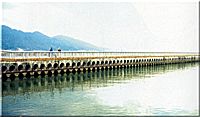
"Color selection also becomes an important issue for anglers to consider as they load their packs for shoreline angling. Show me a lure manufacturer who makes only four colors in a series of baits, and I'll show you, someone who isn't making any money in the tackle business," Jun says with a smile. "Four basic colors or fewer is all you need in your lure selection to cover almost any angling situation. I'll typically try to pack two shad or baitfish colors and two crawdad shades in my worms, jig, and grubs. Similarly, I'll opt for a white or shad color, a chartreuse or chartreuse and blue-colored spinnerbaits. Crankbaits can be limited to baitfish patterns, jerkbaits, and topwater lures. However, if I know that I will be fishing some stained or dirty water, I will include some chartreuse, firetiger, or black and gold crankbait and jerkbaits in my mix. I also try to push my students to downsize their bait selections. The smaller baits are easier to pack but are more subtle on the water and ultimately catch more fish.
"Each body of water will have its nuances, and you should gear up accordingly," Jun adds. "Some waters experience a hot bluegill pattern bite during the spawning season. Others may have many shad-eating bugs on the surface and bass feeding on these shad. Here in Japan, for example, lakes contain these small, brownish-green freshwater shrimp. As a result, we use lots of watermelon/pepper-colored worms and grubs to match these shrimp. The main rule here is if the area you are fishing has a localized condition that may provide you an angling opportunity, carry some baits with you that will allow you to capitalize on these conditions.
"Without a doubt, though," Jun says, "the most significant error most bank anglers make is their approach. Man explores space and the ocean depths, cows walk the fence lines in their pastures, and bass tend to orient themselves to the outer limits of their world - the shoreline. Most bank anglers waltz right down to the edge of the shoreline and make the farthest cast they can. In doing so, they have just cut their chances of catching a bass in half before the first cast even hits the water. Bass have acute visual and sensory perception and react when presented with danger. Three-fourths of the mature bass' natural predators come from the shoreline, whether an osprey, otter, gator, or whatnot. Any shadows, shoreline movement, or bank vibration will trigger the fish's instinct to flee toward deeper water. When an angler walks to the water's edge and makes a cast, he will spook any fish holding tight to the shore.
"I teach my students to approach a spot quietly and make the first cast from several yards back. This dramatically affects the number of bass you will hook on your initial cast. After you have made the first few casts, you can approach the shoreline, survey the situation, and make your casts deeper.
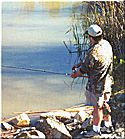
"The second major mistake beginning shoreline anglers make is that most anglers will make their casts perpendicular to the water's edge. I encourage students to make frequent casts parallel to the shoreline before starting to fan-cast out into deeper water. Again, the fish often hold tight to the bank, and simply chunking your bait out into the open water will bypass these fish altogether.
"I should add at this point that one of the most important tools to the shoreline angler is a good pair of polarized sunglasses," Jun says. "Not only will they allow you to see the fish, weedlines, submerged brush, and breaks, but they will protect your eyes as well - and I'm not just talking about from the sun. Unlike anglers fishing from boats which can simply move to a lure they have hung up and work it loose when shoreline anglers get hung up, they have few options to get the bait loose. I've seen anglers snag up and pull their lines so hard that the split shot or worm weight comes rifling back at them when it breaks loose. Fishermen with slow reactions or innocent bystanders can get hit, and I've actually witnessed a pair of sunglasses save someone's eyesight.
"Casting accuracy and a subtle presentation are concepts I stress to my students," Jun adds. "This is an essential skill for anyone interested in bass fishing regardless of whether they are fishing from a boat or bank. Here in Japan, we have many docks, piers, and other man-made structures. The fish like to orient to this structure just like a weedline or submerged brush. A few crashing casts made off the mark can alert or spook fish. So I tell my anglers to take an extra second or two to concentrate on making the best cast possible instead of just winding up and throwing. It can often make a big difference in their cast placement and the number of fish they catch.
"Regarding specialized clothing for bank fishing, I have heard all sorts of debates. 'Should I wear camouflage, dark clothes, or light clothes?' they ask. If you concentrate on using the approach techniques, I stress that clothing color should not be a factor in bank fishing. Wear whatever you are comfortable with. However, I caution against wearing bright colors like reds, yellows, and oranges in spring and summer. Insects are attracted to these bright colors. I typically opt for darker clothing to blend in more with the shoreline. I feel that clothing selection is a lot like using scents on baits - it probably helps and certainly can't hurt, so why not?
"Shoreline fishing also has some ethics involved," Jun told us. "One of the big problems we are currently facing in Japan is the amount of litter left behind by shoreline anglers. Be it discarded line, used hook wrappers, discarded plastic worms, or empty Coke cans, all anglers need to take responsibility for the stuff they bring and tote their garbage out. Not only is the stuff they leave behind visually unappealing and environmentally harmful, but they can also lead to shorelines becoming closed to fishing. So we have launched an awareness campaign to get our shorelines cleaned up. I hope we will see improvement in the future.
"Other things I tell my students to take with them as a part of their shoreline fishing ensemble include a good hat - during the warmer weather. I prefer the long bill style with the flaps in the back to protect my neck from the sun and bugs. I also tell them to bring bug spray, pliers with line cutters, a disposable camera for catch-and-release photos, and waterproof boots or hip waders, depending on where you are fishing. Take food and water if you will be out for an extended time. I also pack a cell phone, and if I'm going into a remote or seldom-traveled area, I'll let someone know where I will be and the approximate time I'll return - just in case something happens and I don't make it back. However, I always try to take a friend fishing with me as it is usually more fun to share the outdoors with someone else."
Reprinted with permission from Bass West Magazine


